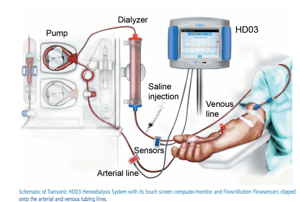What Bioengineers Should Know About Flow Measurement for Dialysis for Renal Replacement
Renown nephrologist Dr. Thomas Depner studied the wear and cavitation of tubing at different pressure pump settings and recognized that actual pump flow can sometimes differ from a pump’s setting during hemodialysis.
Dr. Depner identified the need for a way to independently measure delivered blood  flow to verify the flow set by the pump during prolonged blood pump procedures such as dialysis and ECMO.
flow to verify the flow set by the pump during prolonged blood pump procedures such as dialysis and ECMO.
His observation spurred the development of the Transonic Hemodialysis Monitor that measures delivered pump flow directly with transit-time ultrasound Flowsensors applied to the outside of dialysis lines, and ultimately, the incorporation of Transonic Flowboards and Flowsensors into dialysis machines.
In addition to measuring delivered pump flow, Transonic can measure access recirculation in fistulas, grafts and catheters, vascular access flow in fistulas and grafts and cardiac function of hemodialysis patients.
Learn more about dialysis for renal replacement and Transonic’s offering in this guide.



